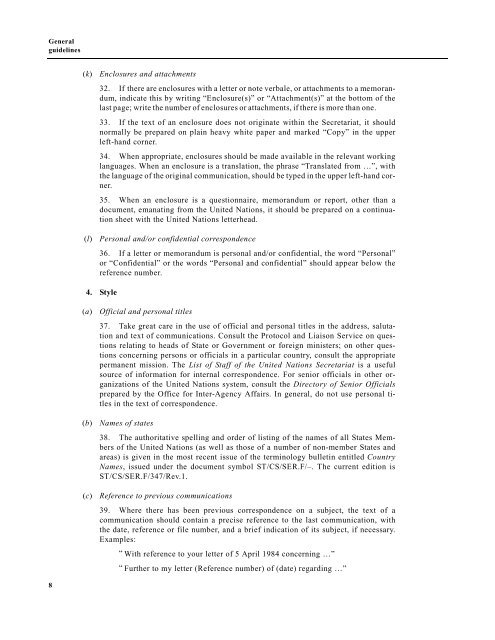United Nations Correspondence Manual - UNU
United Nations Correspondence Manual - UNU
United Nations Correspondence Manual - UNU
Create successful ePaper yourself
Turn your PDF publications into a flip-book with our unique Google optimized e-Paper software.
General<br />
guidelines<br />
8<br />
(k) Enclosures and attachments<br />
32. If there are enclosures with a letter or note verbale, or attachments to a memorandum,<br />
indicate this by writing “Enclosure(s)” or “Attachment(s)” at the bottom of the<br />
last page; write the number of enclosures or attachments, if there is more than one.<br />
33. If the text of an enclosure does not originate within the Secretariat, it should<br />
normally be prepared on plain heavy white paper and marked “Copy” in the upper<br />
left-hand corner.<br />
34. When appropriate, enclosures should be made available in the relevant working<br />
languages. When an enclosure is a translation, the phrase “Translated from …”, with<br />
the language of the original communication, should be typed in the upper left-hand corner.<br />
35. When an enclosure is a questionnaire, memorandum or report, other than a<br />
document, emanating from the <strong>United</strong> <strong>Nations</strong>, it should be prepared on a continuation<br />
sheet with the <strong>United</strong> <strong>Nations</strong> letterhead.<br />
(l) Personal and/or confidential correspondence<br />
36. If a letter or memorandum is personal and/or confidential, the word “Personal”<br />
or “Confidential” or the words “Personal and confidential” should appear below the<br />
reference number.<br />
4. Style<br />
(a) Official and personal titles<br />
37. Take great care in the use of official and personal titles in the address, salutation<br />
and text of communications. Consult the Protocol and Liaison Service on questions<br />
relating to heads of State or Government or foreign ministers; on other questions<br />
concerning persons or officials in a particular country, consult the appropriate<br />
permanent mission. The List of Staff of the <strong>United</strong> <strong>Nations</strong> Secretariat is a useful<br />
source of information for internal correspondence. For senior officials in other organizations<br />
of the <strong>United</strong> <strong>Nations</strong> system, consult the Directory of Senior Officials<br />
prepared by the Office for Inter-Agency Affairs. In general, do not use personal titles<br />
in the text of correspondence.<br />
(b) Names of states<br />
38. The authoritative spelling and order of listing of the names of all States Members<br />
of the <strong>United</strong> <strong>Nations</strong> (as well as those of a number of non-member States and<br />
areas) is given in the most recent issue of the terminology bulletin entitled Country<br />
Names, issued under the document symbol ST/CS/SER.F/–. The current edition is<br />
ST/CS/SER.F/347/Rev.1.<br />
(c) Reference to previous communications<br />
39. Where there has been previous correspondence on a subject, the text of a<br />
communication should contain a precise reference to the last communication, with<br />
the date, reference or file number, and a brief indication of its subject, if necessary.<br />
Examples:<br />
“ With reference to your letter of 5 April 1984 concerning …”<br />
“ Further to my letter (Reference number) of (date) regarding …”




